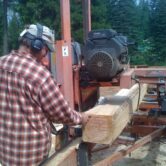
To answer this question there are serval considerations to keep in mind. Lets start with the price of lumber at the lumberyard and then review hiring a portable sawmill operator, verses the option of purchasing your own sawmill.
Lumber Prices
The price of lumber more than doubled from 2020 to 2021. Supply chain disruptions and industrial mills cutting back on production contributed to shortages and price increases.
When the pandemic forced nationwide lockdowns, it forced commercial sawmills, furniture manufacturers and homebuilders to temporarily shut down. Demand for lumber went down and gave some relief to the shortage allowing prices to equalize, a little drop closer to normal. However, economists warn that things might not stay this way.
Now producers are scrambling to catch up with demand. Additionally, record-low interest rates have bolstered new home construction. “So, demand for lumber kind of bounced back even as supply remained constrained,” says Jeremy Moses, a lumber market analyst with IBISWorld.
Hiring a Sawmill
Portable sawmills provide an alternative to going to the lumberyard and paying the curent high prices. For home owners with dead, dying or downed trees this is a viable option. In most cases if homeowners have small quantities of trees or logs the most cost effective method of producing your own lumber is to hire a portable sawmill operator to come on site and mill your lumber. However for tree lot owners with larger tree lots of available timber, purchasing a sawmill could be a viable option.
To get an accurate price of what it will cost to mill your logs, start with determining the board foot quantity of your logs. You can do this with a log scale, learn more. Once you know the total board foot amount of lumber to expect from your logs, this number can be divided by the cost your Sawyer will charge, learn more about how Sawyers price their work here. Some sawmill operators my charge by the board foot, eliminating the need to do the above math on your own. You can take the board foot cost and compare it to the lumber yard. However there are some cuts and dimensions that just aren’t available at local stores. Anytime you try to purchase specialty sizes or highly sought after hardwoods the price will skyrocket.
Buying a Sawmill.
Keep in mind that becoming a proficient Sawyer has a learning curve that can not be taken for granted. As the saying goes; “You can learn to operate a sawmill in one day, but it takes years to become a good Sawyer.” As for myself, starting in 1995, it took me five years of working as a carpenter to pay off my mill, and during this time I butchered many nice logs learning how to be good at what I do. Recently on one of my jobs, I saw first hand how an inexperienced mill operator spent a full week milling what I was able mill in one day. I was told this by the log owner himself, and the waste pile he left amounted to a significant loss to the log owner.
Producing your own lumber can be very gratifying. On the other hand it is a lot of work. Having milled over one and a half million board feet of lumber myself with a portable sawmill, I can attest to the hard work. I have seen a number of mills sitting idle because the hard work was to much for the new mill owner.
In one case serval neighbors got together and purchased a mill. After a week of a community work party, and milling a few trees, each person lost interest because of the intense labor required to move, cut and stack the hard earned lumber. In the end the reality of milling their own lumber was not a glorious and easy project and the mill sits in an empty field getting rusty.
If you are looking to purchase your own sawmill there is already plenty of recommendations out there on different brands. As for me I use the Wood-Mizer LT40HD. When asked about what mill is best, the first thing I recommend is to make a realistic assessment of your unique situation. It is like an engineering equation. You need to consider the size and species of trees you will be milling. How much or how often you will be using your sawmill and is this use for the weekend wood worker or are you considering making some money working full or part time.
Some mills are better suited for small diameter, short logs. Others will handle logs up to 36 inch diameter and 16 or 20 foot long logs. Still there are a few that specialize in large diameter logs over 48 inches. And then there are the industrial quality high production mills.
The above details should be the first thing to pin down along with your budget before spending to much time looking at the different mills out there. I hope this information will put you on the right track to getting your logs processed into lumber.

Sawyer
Ron Trout
“Operating Wood-Mizer LT40HD since 1995, producing over one million board feet of lumber.”

Comments